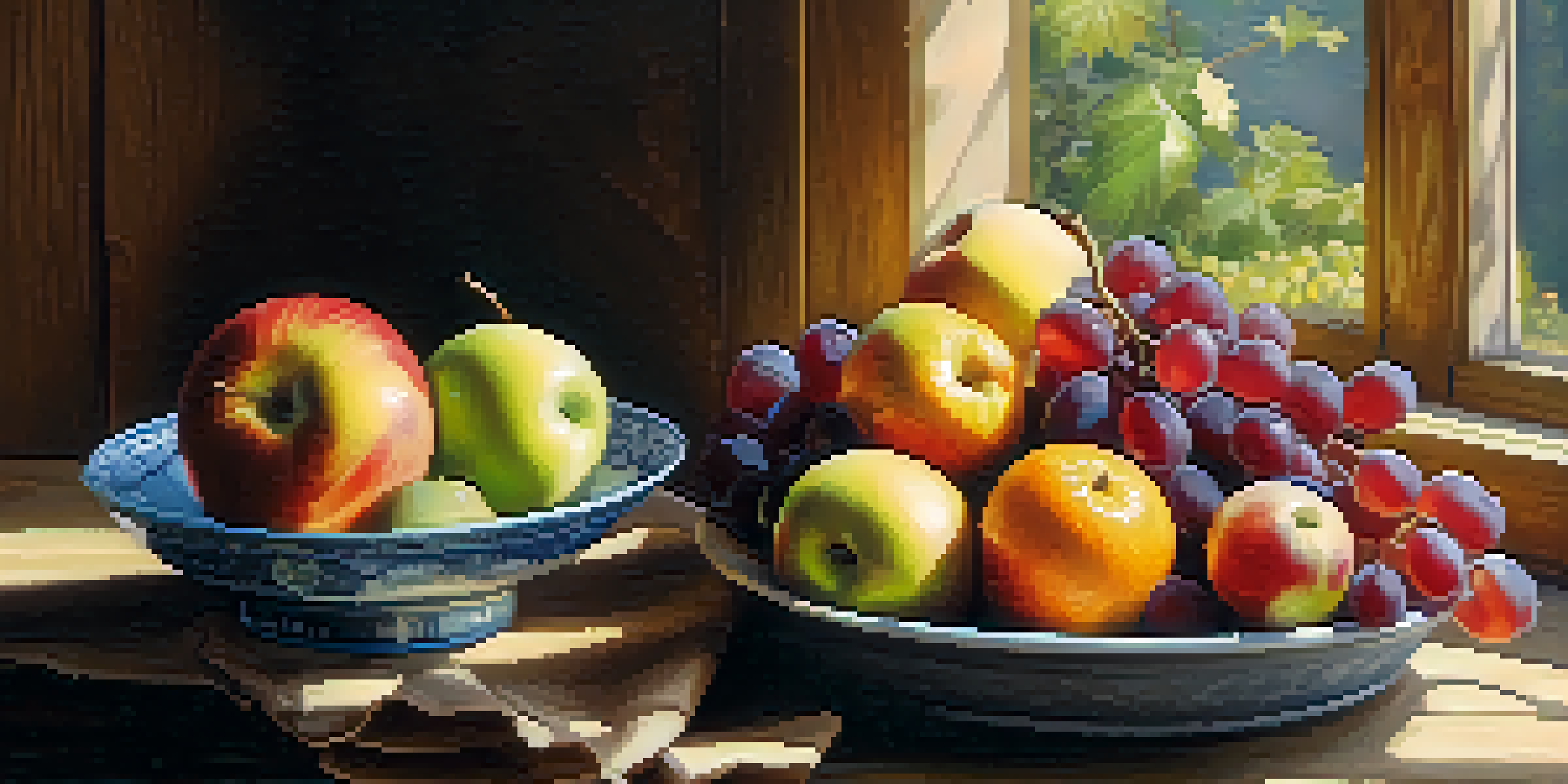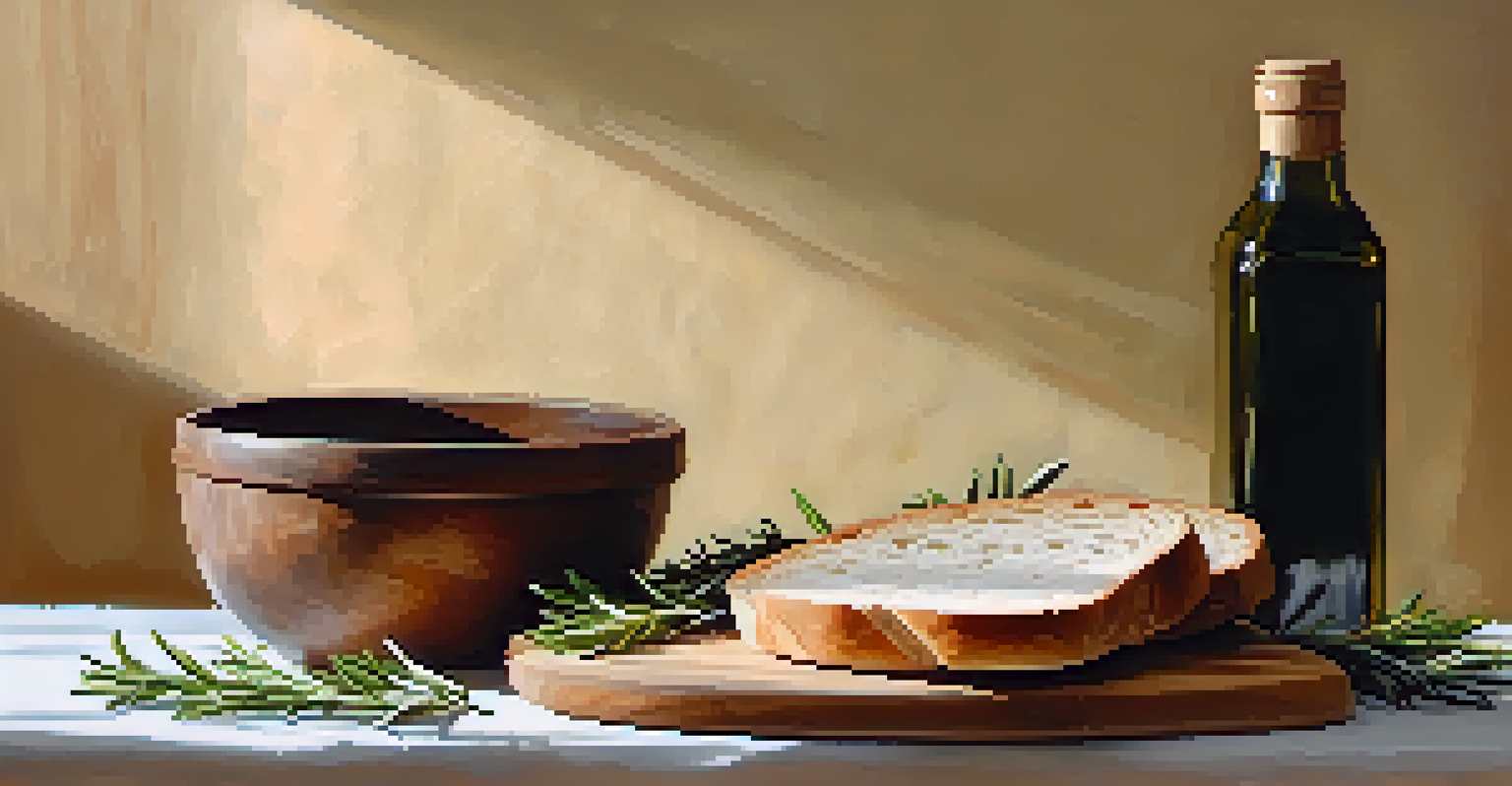Materials and Tools for Traditional Still Life Painting

Understanding the Basics of Still Life Painting
Still life painting is a captivating art form that focuses on inanimate objects, often arranged in a visually pleasing manner. This genre allows artists to explore composition, light, and color without the complexities of live subjects. By mastering still life, artists can enhance their skills in observation and technique, making it a foundational practice in art education.
Still life is not just a collection of objects; it’s a way of exploring the world around us and finding beauty in the ordinary.
The beauty of still life lies in its simplicity; a bowl of fruit or a vase of flowers can tell a story through color and form. Artists can experiment with different arrangements and lighting to evoke various moods and feelings. This makes it a versatile subject, appealing to both beginners and seasoned professionals alike.
In this article, we will delve into the essential materials and tools that every artist needs to embark on their still life journey. Whether you’re a novice or a pro, having the right setup can significantly enhance your creative process and the quality of your work.
Choosing the Right Canvas for Your Artwork
The canvas serves as the foundation of any painting, and selecting the right one for still life is crucial. Typically, artists opt for cotton or linen canvases, with cotton being a cost-effective option for beginners. Linen, on the other hand, is a premium material that offers a smooth texture and durability, making it ideal for more experienced artists.

Another option is wood panels, which provide a solid surface that can hold paint exceptionally well. This choice can enhance the depth and detail in your still life, especially if you are using oil paints. Regardless of your choice, ensure that your canvas is primed properly to prevent the paint from soaking through and to maintain vibrant colors.
Mastering Still Life Basics
Still life painting allows artists to enhance their skills in observation, composition, and technique through the arrangement of inanimate objects.
Ultimately, your canvas choice will influence the overall feel of your painting. Consider experimenting with various surfaces to find the one that best complements your style and the subjects you wish to depict.
Essential Brushes for Still Life Techniques
Brushes are an artist's primary tool for applying paint, and selecting the right kind is essential for achieving desired effects in still life painting. A variety of brush shapes—such as flat, round, and filbert—each serve a unique purpose. For example, flat brushes are excellent for covering large areas, while round brushes are perfect for detail work.
The canvas is a place where imagination meets reality, allowing artists to capture the essence of what they see and feel.
Natural bristle brushes are favored for oil painting due to their stiffness, which allows for better paint control. Synthetic brushes, however, can be more versatile and are often easier to clean. As you practice, you’ll find which brushes work best for your technique and preferred medium.
Don’t shy away from experimenting with different brush sizes and shapes; this can lead to unique textures and strokes that bring your still life to life. Each brush can tell a different story, so choose wisely and embrace the creative journey.
Selecting the Right Paints for Your Still Life
When it comes to paints, the options can be overwhelming, but the choice often boils down to two main types: oil and acrylic. Oil paints offer a rich, vibrant finish and allow for blending over extended periods, making them ideal for detailed still life work. However, they do require more drying time and careful handling.
Acrylic paints, on the other hand, dry quickly, which is great for artists who prefer to work fast or layer their colors. They are also water-soluble, making them easier to clean up and less toxic. Each medium has its own set of advantages, so consider your working style when making your choice.
Choosing Quality Materials
Selecting the right canvas, brushes, and paints is essential for achieving the desired effects and ensuring the longevity of your artwork.
Regardless of the type of paint you choose, invest in high-quality brands to ensure that your artwork has the best possible vibrancy and longevity. Quality paints will yield better results and enhance your overall painting experience.
The Importance of a Good Palette
A palette is where the magic happens—it's where you mix your colors and create the perfect hues for your still life. Whether you opt for a traditional wooden palette, a disposable paper palette, or a glass surface, the choice should suit your painting style. A good palette allows for easy color mixing and helps you keep track of your color choices throughout your session.
Consider using a limited color palette to simplify your mixing process and create a more cohesive look in your artwork. This approach encourages creativity and helps you focus on color relationships rather than getting lost in too many options. You might be surprised at how beautiful your still life can be with just a few carefully selected colors.
Don’t forget to clean your palette regularly, as old paint can muddy your colors and affect your final piece. Maintaining a clean workspace not only helps your art but also keeps your creative process enjoyable.
Setting Up Your Still Life Composition
Setting up your still life composition is an art in itself. Start by selecting objects that resonate with you; they could be fruits, flowers, or everyday items that tell a story. Arrange them in a way that creates balance and interest, considering factors like height, shape, and color contrast to draw the viewer's eye.
Lighting plays a crucial role in how your still life is perceived. Natural light can create beautiful shadows and highlights, adding depth to your composition. Experiment with different light sources, such as lamps or diffused sunlight, to see how they influence the mood of your painting.
Creating Compelling Compositions
A successful still life composition involves thoughtful object arrangement, effective lighting, and a willingness to adapt as you paint.
Lastly, don’t hesitate to change your arrangement as you paint. Often, the best compositions evolve as you work, allowing for spontaneous creativity. Embrace this fluidity, and remember that the process is just as important as the final result.
Finishing Touches: Varnishing Your Artwork
Once your still life painting is complete, you might wonder how to protect and enhance it. Varnishing is an essential step that not only preserves your artwork but also unifies the surface sheen, making colors appear more vibrant. There are several types of varnishes available, including gloss, satin, and matte, each offering a different finish.
Applying varnish can also safeguard your painting from dust, UV rays, and environmental factors that may cause fading over time. Be sure to wait until your paint is fully dry before applying varnish, as using it on wet paint can create unwanted effects.

Remember that varnishing is a personal choice; some artists prefer the raw look of unvarnished paintings. Ultimately, the decision comes down to the effect you want to achieve and how you wish your still life to be experienced.